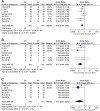Does zero-profile anchored cage accompanied by a higher postoperative subsidence compared with cage-plate construct? A meta-analysis
- PMID: 32448320
- PMCID: PMC7247200
- DOI: 10.1186/s13018-020-01711-9
Does zero-profile anchored cage accompanied by a higher postoperative subsidence compared with cage-plate construct? A meta-analysis
Abstract
Background: The zero-profile anchored cage (ZP) has been widely used for its lower occurrence of dysphagia. However, it is still controversial whether it has the same stability as the cage-plate construct (CP) and increases the incidence of postoperative subsidence. We compared the rate of subsidence after anterior cervical discectomy and fusion (ACDF) with ZP and CP to determine whether the zero-profile device had a higher subsidence rate.
Methods: We performed a meta-analysis of studies that compared the subsidence rates of ZP and CP. An extensive and systematic search covered the PubMed and Embase databases according to the PRISMA guidelines and identified ten articles that satisfied our inclusion criteria. Relevant clinical and radiological data were extracted and analyzed by the RevMan 5.3 software.
Results: Ten trials involving 626 patients were included in this meta-analysis. The incidence of postoperative subsidence in the ZP group was significantly higher than that in the CP group [15.1% (89/588) versus 8.8% (51/581), OR = 1.97 (1.34, 2.89), P = 0.0005]. In the subgroup analysis, we found that the definition of subsidence did not affect the higher subsidence rate in the ZP group. Considering the quantity of operative segments, there was no significant difference in the incidence of subsidence between the two groups after single-level fusion (OR 1.43, 95% CI 0.61-3.37, P = 0.41). However, the subsidence rate of the ZP group was significantly higher than that of the CP group (OR 2.61, 95% CI 1.55-4.40, P = 0.0003) after multilevel (≥ 2-level) procedures. There were no significant differences in intraoperative blood loss, JOA score, NDI score, fusion rate, or cervical alignment in the final follow-up between the two groups. In addition, the CP group had a longer operation time and a higher incidence of dysphagia than the ZP group at each follow-up time.
Conclusion: Based on the limited evidence, we suggest that ZP has a higher risk of postoperative subsidence than CP, although with elevated swallowing discomfort. A high-quality, multicenter randomized controlled trial is required to validate our results in the future.
Keywords: Anterior fusion; Cervical degenerative disease; Meta-analysis; Subsidence; Zero-profile device.
Conflict of interest statement
The authors declare that they have no competing interests.
Figures












Similar articles
-
Comparison of anterior cervical discectomy and fusion with the zero-profile device versus plate and cage in treating cervical degenerative disc disease: A meta-analysis.J Clin Neurosci. 2016 Nov;33:11-18. doi: 10.1016/j.jocn.2016.01.046. Epub 2016 Jul 18. J Clin Neurosci. 2016. PMID: 27443497 Review.
-
Incidence of Subsidence of Seven Intervertebral Devices in Anterior Cervical Discectomy and Fusion: A Network Meta-Analysis.World Neurosurg. 2020 Sep;141:479-489.e4. doi: 10.1016/j.wneu.2020.03.130. Epub 2020 Apr 3. World Neurosurg. 2020. PMID: 32251812 Review.
-
Comparison of Clinical and Radiologic Outcomes Between Self-Locking Stand-Alone Cage and Cage with Anterior Plate for Multilevel Anterior Cervical Discectomy and Fusion: A Meta-Analysis.World Neurosurg. 2019 May;125:e117-e131. doi: 10.1016/j.wneu.2018.12.218. Epub 2019 Jan 21. World Neurosurg. 2019. PMID: 30677575
-
[Comparison of effectiveness between zero-profile anchored cage and plate-cage construct in treatment of consecutive three-level cervical spondylosis].Zhongguo Xiu Fu Chong Jian Wai Ke Za Zhi. 2025 Feb 15;39(2):193-200. doi: 10.7507/1002-1892.202410092. Zhongguo Xiu Fu Chong Jian Wai Ke Za Zhi. 2025. PMID: 39971365 Free PMC article. Chinese.
-
Locking stand-alone cages versus anterior plate constructs in single-level fusion for degenerative cervical disease: a systematic review and meta-analysis.Eur Spine J. 2017 Sep;26(9):2258-2266. doi: 10.1007/s00586-017-5015-9. Epub 2017 Mar 10. Eur Spine J. 2017. PMID: 28283840
Cited by
-
Anterior cervical discectomy and fusion with zero-profile versus stand-alone cages for two-level cervical spondylosis: A retrospective cohort study.Front Surg. 2022 Nov 2;9:1002744. doi: 10.3389/fsurg.2022.1002744. eCollection 2022. Front Surg. 2022. PMID: 36406351 Free PMC article.
-
Are Variable Screw Angle Change and Screw-to-Vertebral Body Ratio Associated With Radiographic Subsidence Following Anterior Cervical Discectomy and Fusion?Global Spine J. 2025 Apr;15(3):1582-1591. doi: 10.1177/21925682241252088. Epub 2024 May 5. Global Spine J. 2025. PMID: 38706298 Free PMC article.
-
Zero-profile anchored spacer versus conventional plate-cage construct in bilevel anterior cervical discectomy and fusion: a systematic review and meta-analysis.J Orthop Surg Res. 2023 Aug 31;18(1):644. doi: 10.1186/s13018-023-04134-4. J Orthop Surg Res. 2023. PMID: 37653510 Free PMC article.
-
Outcomes of different zero-profile spacers in the treatment of two-level cervical degenerative disk disease.Eur Spine J. 2023 Jul;32(7):2448-2458. doi: 10.1007/s00586-023-07756-8. Epub 2023 May 17. Eur Spine J. 2023. PMID: 37198504
-
Zero-profile implant versus conventional cage-plate construct in anterior cervical discectomy and fusion for the treatment of single-level degenerative cervical spondylosis: a systematic review and meta-analysis.J Orthop Surg Res. 2022 Nov 24;17(1):506. doi: 10.1186/s13018-022-03387-9. J Orthop Surg Res. 2022. PMID: 36434694 Free PMC article.
References
-
- Oliver JD, Goncalves S, Kerezoudis P, Alvi MA, Freedman BA, Nassr A, Bydon M. Comparison of outcomes for anterior cervical discectomy and fusion with and without anterior plate fixation: a systematic review and meta-analysis. Spine. 2018;43(7):E413–E422. doi: 10.1097/BRS.0000000000002441. - DOI - PubMed
Publication types
MeSH terms
LinkOut - more resources
Full Text Sources
Medical
Miscellaneous

